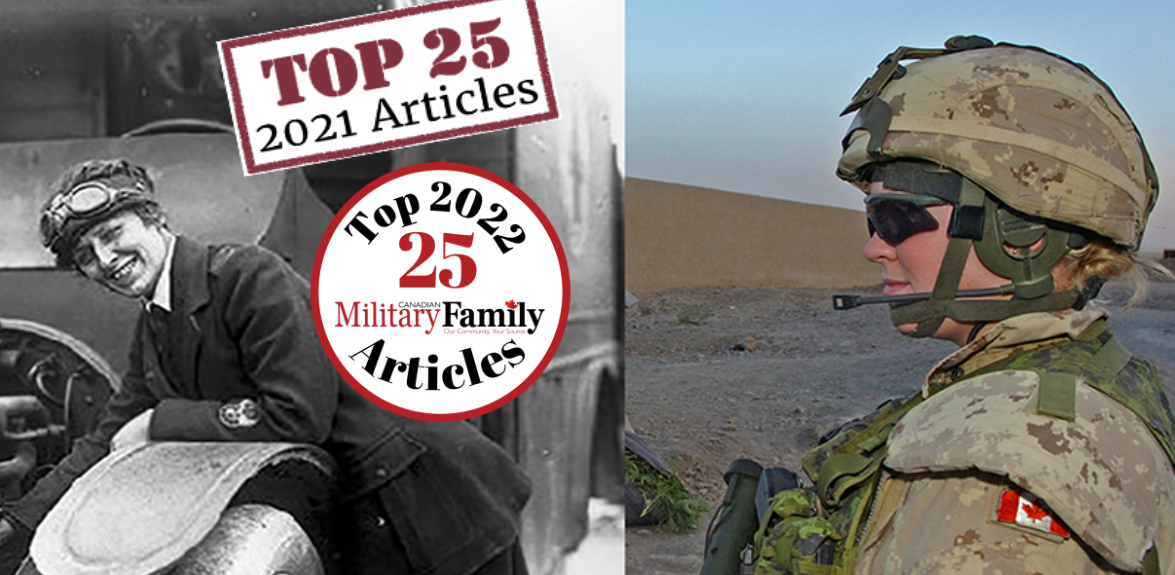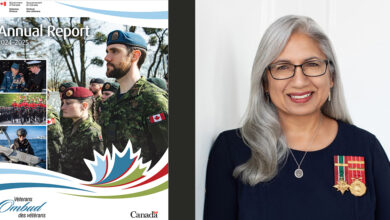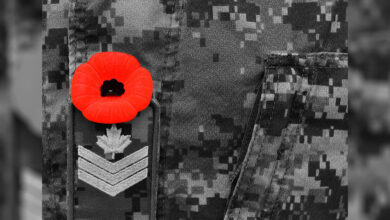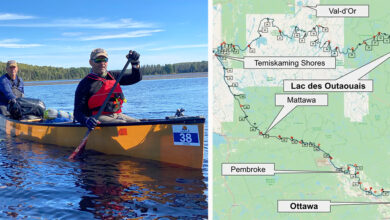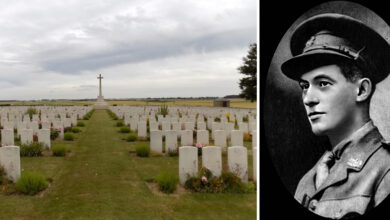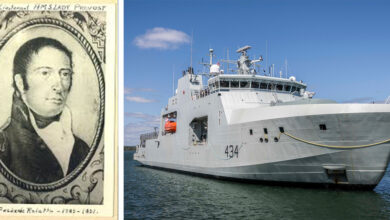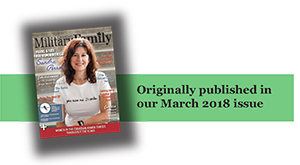 Women have a proud and storied history of serving in the Canadian Armed Forces (CAF). For more than 100 years, whether it was nursing wounded soldiers or taking the battlefield by storm, women have stepped up in times of need to serve their country.
Women have a proud and storied history of serving in the Canadian Armed Forces (CAF). For more than 100 years, whether it was nursing wounded soldiers or taking the battlefield by storm, women have stepped up in times of need to serve their country.
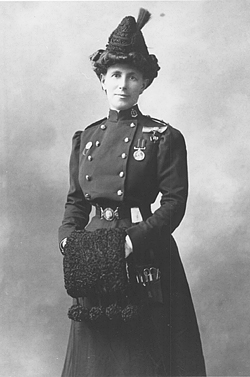
Today, women serve in various trades across the board, and the age of gender equality has been ushered in by the CAF. However, it took many decades and a number of brave women to pave the way for today’s gender-equal Canadian military.
It was in 1885 that women first made their mark on Canadian military history when they served as nurses during the Northwest Rebellion, albeit as civilians.
For the next few decades until the First World War, women only served as nurses. Then, for the first time, women served outside the nursing capacity with the creation of female paramilitary groups. These women dressed in military-style uniforms and trained in small arms, first aid, and vehicle maintenance in case a force was needed on the home front.
However, women still primarily served in a nursing capacity. There were 2,800 nurses, mostly women, who served with the Royal Canadian Army Medical Corps.
During the Second World War, women served their country valiantly again. The Second World War saw the largest number of women who have ever served in the Canadian Armed Forces at one time. They again largely served in a nursing capacity, more than 5,000 nurses, mostly women, served in the Army, Navy, and Air Force Medical Corps.
Additionally, the Canadian government recruited more than 45,000 volunteers for full-time military service in the women’s divisions of all three services. As the war progressed, the range of duties for these members expanded from clerks, cooks, drivers, and telephone operators to include mechanics, parachute riggers, and heavy mobile equipment drivers.
After the Second World War, women continued to serve in the military in roles traditionally geared towards females. In the 1970s, however, a number of government reviews looked into how women could contribute in a broader range of trades.
Thanks to the persistence and bravery of these pioneers, in 1989 the combat arms were finally opened to women, and eleven years later submarine service was also opened to women. The CAF became one of the first and few militaries in the world to allow women in all occupations.
“Women in the Canadian Armed Forces today are proud to be carrying the torch of the generations of Canadian women who served as trailblazers before us and who opened doors to the wide range of career options and opportunities that we now enjoy across Canadian society. We can take great pride in the incredible contributions that Canadian servicewomen have made and continue to make, and the positive changes we have influenced for women and girls here in Canada, and around the world. While we honour our history, we also continue to look towards the future, seeking new ways for women in Canada to demonstrate success, and encourage the trailblazers and leaders of tomorrow,” said RAdm. Jennifer Bennett Defence Champion for Women.
Today’s gender-inclusive CAF is working towards increasing the number of women in the services. The goal is to increase the number of female CAF members by one per cent every year so that in ten years’ time, one in four members of the CAF will be women.
In January 2017, the CAF General and Flag Officer appointments and promotions resulted in the largest number of women, nine, serving in the senior ranks in CAF history.
1885Women serve as nurses for the first time in Canadian military history during the Northwest Rebellion, albeit in a civilian capacity.
1898-1902
Nurses start supporting the Yukon Field Force in 1898.
Following the formation of the Canadian Army Medical Department in June 1899, the Canadian military creates an Army Nursing Service in 1901. The Service dispatches four nurses to support a volunteer force of 1000 Canadians in South Africa during the Boer War. The Service grants these nurses the relative rank, pay, and allowances of an army lieutenant. By the war’s end on May 31, 1902, eight Canadian Nursing Sisters and more than 7000 Canadian soldiers volunteer for service in South Africa.
1914-1918
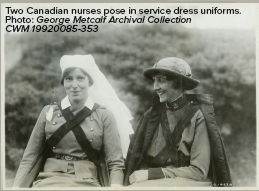 More than 2800 nurses serve with the Royal Canadian Army Medical Corps during the First World War. The majority of these women work overseas in hospitals, on board hospital ships, in several theatres of war, and in combat zones with field ambulance units.
More than 2800 nurses serve with the Royal Canadian Army Medical Corps during the First World War. The majority of these women work overseas in hospitals, on board hospital ships, in several theatres of war, and in combat zones with field ambulance units.
The First World War also sees the creation of female paramilitary groups that, for the first time, provide women with a means to serve outside of nursing. The members of these groups dress in military-style uniforms and train in small arms, drill, first aid, and vehicle maintenance in case they are needed as home guards.
1939-1945
Approximately 5000 nurses serve in the Army, Navy, and Air Force Medical Corps during the Second World War. They serve overseas in hospitals, casualty stations near combat zones, mobile field hospitals, and in many theatres of war. However, they are excluded from service on warships, combat aircraft, or in combat arms units.
1941
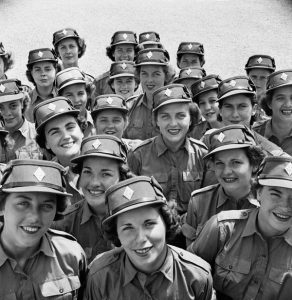
The Canadian government recruits more than 45 000 volunteers for full-time military service in the women’s divisions of all three services. The range of duties for members of these divisions expands during the Second World War from traditional trades such as clerks, cooks, drivers, and telephone operators to include mechanics, parachute riggers, and heavy mobile equipment drivers.
1942
Mary Greyeyes of Saskatchewan’s Muskeg Lake Indian Reserve becomes the first Aboriginal woman to enlist in the Canadian Army.
1950-1953
Women enlist when Canada commits military forces to the Korean War. More than 5000 women are serving by 1955.
1965
The Canadian military continues to employ women with a fixed ceiling of 1500 for female enrollment in all three services. This ceiling represents approximately 1.5 percent of the CAF’s total strength in 1965.
1970
As part of its mandate to advise the Government of Canada on how to increase equal opportunity for Canadian women, the Royal Commission on the Status of Women makes six recommendations aimed specifically at the CAF:
- standardize military enrolment criteria;
- establish equal pension benefits for women and men;
- allow women to attend Canadian military colleges;
- open all military trades and officer classifications to women; and
- remove regulations prohibiting the enrolment of married women and requiring the release of servicewomen upon the birth of a child.
1978
Corporal Gail Toupin becomes the first female member of the SkyHawks, the Army’s skydiving demonstration team.
1979-1985
The CAF runs trials as part of the Servicewomen in Non-Traditional Environments and Roles (SWINTER) project.
1979
Canadian military colleges open their doors to women.
1981
Captain Dee Brasseur, Captain Leah Mosher, and Captain Nora Bottomley become the first three women to serve as RCAF pilots, following the opening of the pilot classification to women in 1980.
Second Lieutenant Inge Plug becomes the first female helicopter pilot.
Lieutenant Karen McCrimmon becomes the first female air navigator.
1982
Canada adopts the Canadian Charter of Rights and Freedoms, which prohibits discrimination based on race, national or ethnic origin, colour, religion, sex, age, and mental or physical disability.
1987
Brigadier-General Sheila A. Hellstrom becomes the first female officer to hold that rank.
The CAF launches Combat Related Employment of Women trials for selected army units and naval vessels. The Air Force announces that no further trials are required and all Air Force occupations, including fighter pilot, are open to women.
1986-1988
Following a discrimination complaint, Canadian Human Rights Tribunal instructs the CAF to:
- continue the Combat Related Employment trials as preparation for the full integration of women in all military occupations;
- integrate women into all aspects of the Regular and Reserve Forces, with the exception of submarines;
- remove all employment restrictions and implement new occupational personnel selection standards; and
- devise a plan to steadily, regularly, and consistently achieve complete integration within ten years.
1988
The first serving women gunners in the Regular Force graduate from qualification 3 training. The CAF posts them to the 5e Régiment d’artillerie légère (5 RALC) in Valcartier, Quebec, as part of the Combat Related Employment for Women (CREW) trials.
Private Shannon Wills wins the Queen’s Medal for Champion Shot of the Reserve Forces at the Connaught Ranges in Ottawa.
1989
Private Heather R. Erxleben becomes Canada’s first female infantry soldier.
Major Dee Brasseur and Captain Jane Foster become the first two female pilots in the world to qualify to fly the CF-18 Hornet jet fighter.
1990
The Minister of National Defence creates an Advisory Board on Women in the Canadian Forces to monitor the progress of gender integration and employment equity in the CAF.
1991
HMCS Nipigon becomes the first Canadian mixed-gender warship to participate in exercises with NATO’s Standing Naval Force Atlantic.
Lieutenant Anne Reiffenstein, Lieutenant Holly Brown, and Captain Linda Shrum become the first female officers in combat arms, serving in the artillery.
1992
Corporal Marlene Shillingford becomes the first female member of the Snowbirds, while serving as a technician for the Air Force’s aerobatic demonstration flying team.
1993
Lieutenant (Navy) Leanne Crowe is the first woman to qualify as a clearance diving officer and subsequently the first female Commanding Officer of the Experimental Diving Unit.
1994
Major-General Wendy Clay becomes the first woman promoted to that rank.
1995
Chief Warrant Officer Linda Smith becomes the first female Wing Chief Warrant Officer, serving at 17 Wing Winnipeg.
1996
Lieutenant Commander Wafa Dabbagh becomes the first CAF member to wear the hijab.
1997
Colonel Marcia Quinn assumes command of 41 Canadian Brigade Group.
Colonel Patricia Samson becomes the first female Canadian Forces Provost Marshall.
Captain Eva Martinez becomes first Canadian woman to serve as a United Nations Military Observer as part of Operation Vision.
1998
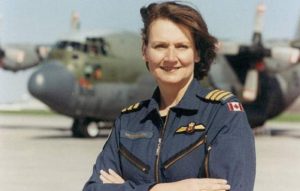
Lieutenant-Colonel Karen McCrimmon becomes the first woman to command an Air Force squadron, as Commander of 429 Transport Squadron in Trenton, Ontario.
Chief Petty Officer Second Class Holly Kisbee becomes the first woman Combat Chief of a major warship.
2000
Major Micky Colton becomes the first female pilot to complete 5000 flying hours in a Hercules aircraft.
Lieutenant Ruth-Ann Shamuhn becomes the first female combat diver.
2001
The Chief of the Defence Staff announces that women can serve in submarines.
Captain Maryse Carmichael is the first female Snowbird pilot, for the Air Force’s aerobatic demonstration flying team.
2002
Chief Warrant Officer Camille Tkacz is the first woman appointed to a Command Chief position as Assistant Deputy Minister (Human Resources – Military) Chief Warrant Officer.
2003
Major Anne Reiffenstein is the first female to command a combat arms sub-unit.
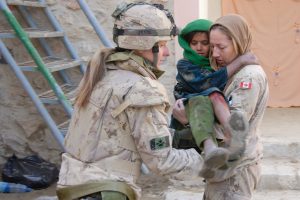
20 January 2008
Spin Boldak, Afghanistan
Master Corporal Anouk Beaudet (left) tending to a young Afghan girl suffering from a burn, with the help of Captain Hélène Lescelleur, at a free medical clinic run by Afghan, Canadian and US medical and dental personnel in Spin Boldak, Afghanistan. Squadron A, 12e Régiment blindé du Canada (12 RBC), also distributed shoes to nearly 1,000 young Afghans.
Joint Task Force Afghanistan (JTF-Afg), Roto 4, is made up of 2,500 Canadian Forces soldiers originating mainly from elements of 5 Canadian Mechanized Brigade Group (5 CMBG) based at CFB Valcartier, Quebec. JTF-Afg, under the command of Brigadier-General Guy Laroche, has been deployed to Kandahar Province, Afghanistan, and forms part of the International Security Assistance Force (ISAF). Canadian soldiers are playing a key role in the NATO-led mission to improve security and assist in rebuilding the country.
Canada is in Afghanistan at the request of the UN, which has reissued a call to the international community to support Afghanistan’s democratically elected government. The aim of the UN-sanctioned NATO mission is to help build a stable, democratic and self-sufficient society in the country.
Photo: Cpl Simon Duchesne, photographer, HQ Afg, Roto 4
Lieutenant-Commander Marta Mulkins is the first woman to serve as a captain of a Canadian warship.
Major Jennie Carignan becomes the first female Deputy Commanding Officer of a combat arms unit, for 5 Combat Engineer Regiment (5 CER).
Leading Seaman Hayley John and Leading Seaman Marketa Semik become the first female non-commissioned member clearance divers.
Master Seaman Colleen Beattie becomes the first female qualified as a submariner, followed shortly by Master Seaman Carey Ann Stewart.
The first and only all-female Canadian Forces team completes the Nijmegen March in Holland carrying the same weight as male teams. They are: team leader Lieutenant Debbie Scott, second-in-command Captain Lucie Mauger, Lieutenant Jody Weathered, Corporal Elizabeth Mutch, Warrant Officer Nathalie Mercer, Warrant Officer Jackie Revell, Master Corporal Denise Robert, Corporal Melissa Cedilot, Corporal Danette Frasz, Lieutenant-Colonel Teresa McNutt, Lieutenant Donna Rogers and Corporal Anne MacDonald.
2004
Chief Petty Officer 1st Class Jan Davis becomes the first female Coxswain of a major warship – HMCS Regina.
2006
Brigadier-General Christine Whitecross becomes the first woman to command Joint Task Force North.
Captain Nicola Goddard was the first female killed in action in Afghanistan, serving with the 1st Regiment Royal Canadian Horse Artillery.
2007
Lieutenant-Colonel Tammy Harris becomes the first female Wing Commander at 9 Wing Gander.
Commodore Jennifer Bennett becomes the first female Commander of the Naval Reserve and the first woman to command a naval formation.
2008
Vice-Admiral Drew Robertson becomes the first Defence Champion for Women.
2009
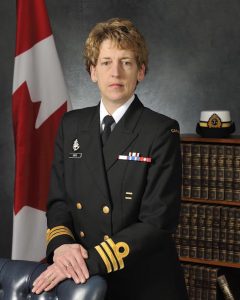
Commander Josée Kurtz becomes the first female commander of a major warship – HMCS Halifax.
2010Lieutenant-Colonel Susan Wigg becomes the first female Director for Cadets for the Royal Military College. In 1980, she had been one of the initial women to enroll at the college.
Lieutenant-Colonel Maryse Carmichael becomes the first female Commanding Officer of the Snowbirds.
2011
Rear-Admiral Jennifer Bennett becomes the first female Rear-Admiral in the RCN and first female Chief Reserves and Cadets, the CAF’s highest Reserve Force position.
2012
Commander Michelaine Lahaie becomes the first female Commanding officer for the Canadian Forces Leadership and Recruit School.
Captain Ashley Collette becomes the first female to receive the Medal of Military Valour for her “fortitude under fire and performance in combat” as a Platoon Commander in Nakhonay, Kandahar Province, Afghanistan, from May to December 2010.
Colonel Tammy Harris becomes the first female base commander of CFB Borden.
2013
Rear-Admiral Jennifer Bennett becomes the first female Defence Champion for Women.
Colonel Jennie Carignan becomes the first female Commandant of Royal Military College Saint-Jean.
Chief Warrant Officer France Dupuis becomes the first female Chief Warrant Officer at Royal Military College Saint-Jean.
2015
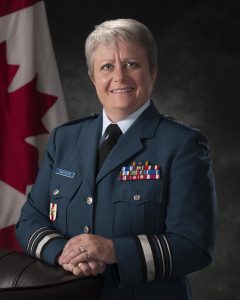
Lieutenant-General Christine Whitecross becomes the first female promoted to that rank and the first female commander of Military Personnel Command.
Brigadier-General Lise Bourgon becomes the first female commander of a Joint Task Force on operations overseas, commanding JTF-Iraq during Op Impact.
2016
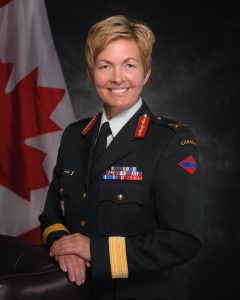
Brigadier-General Jennie Carignan becomes the first female general in the CAF combat arms.
Lieutenant-General Christine Whitecross becomes the first female Commandant of the NATO Defense College in Rome.
Chief Warrant Officer Colleen Halpin becomes the first female Chief Warrant Officer for the Vice Chief of the Defence Staff Group.
2017
Major-General Tammy Harris becomes the first female deputy commander of an Environmental Command (the Royal Canadian Air Force).
Commodore Genvieve Bernatchez becomes the first female CAF Judge Advocate General
CWO Veronica Gibson was appointed as the Formation Chief Warrant Officer of the Canadian Materiel Support Group within Canadian Joint Operations Command.
The Canadian Armed Forces achieve the highest number of female General/Flag Officers in history with a total of twelve including one Lieutenant General, two Major General/Rear Admiral, and nine Brigadier-General/Commodore with four in the RCN, four in the Canadian Army and four in the RCAF.
There are four female Chief Warrant Officer/Chief Petty Officers currently occupying Senior Appointments.
Women make up 10.2% of the strength of the Special Operations Command (CANSOFCOM).


